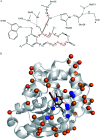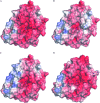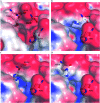Computational design of enhanced detoxification activity of a zearalenone lactonase from Clonostachys rosea in acidic medium
- PMID: 35527979
- PMCID: PMC9072336
- DOI: 10.1039/c9ra04964a
Computational design of enhanced detoxification activity of a zearalenone lactonase from Clonostachys rosea in acidic medium
Abstract
Computational design of pH-activity profiles for enzymes is of great importance in industrial applications. In this research, a computational strategy was developed to engineer the pH-activity profile of a zearalenone lactonase (ZHD101) from Clonostachys rosea to promote its activity in acidic medium. The active site pK a values of ZHD101 were computationally designed by introducing positively charged lysine mutations on the enzyme surface, and the experimental results showed that two variants, M2(D157K) and M9(E171K), increased the catalytic efficiencies of ZHD101 modestly under acidic conditions. Moreover, two variants, M8(D133K) and M9(E171K), were shown to increase the turnover numbers by 2.73 and 2.06-fold with respect to wild type, respectively, though their apparent Michaelis constants were concomitantly increased. These results imply that the active site pK a value change might affect the pH-activity profile of the enzyme. Our computational strategy for pH-activity profile engineering considers protein stability; therefore, limited experimental validation is needed to discover beneficial mutations under shifted pH conditions.
This journal is © The Royal Society of Chemistry.
Conflict of interest statement
There are no conflicts of interest to declare.
Figures






Similar articles
-
Zearalenone lactonase: characteristics, modification, and application.Appl Microbiol Biotechnol. 2022 Nov;106(21):6877-6886. doi: 10.1007/s00253-022-12205-5. Epub 2022 Sep 29. Appl Microbiol Biotechnol. 2022. PMID: 36173450 Review.
-
Mutation, food-grade expression, and characterization of a lactonase for zearalenone degradation.Appl Microbiol Biotechnol. 2023 Aug;107(16):5107-5118. doi: 10.1007/s00253-023-12638-6. Epub 2023 Jul 4. Appl Microbiol Biotechnol. 2023. PMID: 37401996
-
Metabolism of zearalenone by genetically modified organisms expressing the detoxification gene from Clonostachys rosea.Appl Environ Microbiol. 2004 Jun;70(6):3239-45. doi: 10.1128/AEM.70.6.3239-3245.2004. Appl Environ Microbiol. 2004. PMID: 15184117 Free PMC article.
-
Zearalenone detoxification by zearalenone hydrolase is important for the antagonistic ability of Clonostachys rosea against mycotoxigenic Fusarium graminearum.Fungal Biol. 2014 Apr;118(4):364-73. doi: 10.1016/j.funbio.2014.01.005. Epub 2014 Feb 12. Fungal Biol. 2014. PMID: 24742831
-
Biology and applications of Clonostachys rosea.J Appl Microbiol. 2020 Sep;129(3):486-495. doi: 10.1111/jam.14625. Epub 2020 Mar 15. J Appl Microbiol. 2020. PMID: 32115828 Review.
Cited by
-
Excavation, expression, and functional analysis of a novel zearalenone-degrading enzyme.Folia Microbiol (Praha). 2022 Aug;67(4):633-640. doi: 10.1007/s12223-022-00967-4. Epub 2022 Mar 29. Folia Microbiol (Praha). 2022. PMID: 35349103
-
Acid-resistant enzymes: the acquisition strategies and applications.Appl Microbiol Biotechnol. 2023 Oct;107(20):6163-6178. doi: 10.1007/s00253-023-12702-1. Epub 2023 Aug 24. Appl Microbiol Biotechnol. 2023. PMID: 37615723 Review.
-
The Motion Paradigm of Pre-Dock Zearalenone Hydrolase Predictions with Molecular Dynamics and the Docking Phase with Umbrella Sampling.Molecules. 2023 Jun 4;28(11):4545. doi: 10.3390/molecules28114545. Molecules. 2023. PMID: 37299021 Free PMC article.
-
The Protein Engineering of Zearalenone Hydrolase Results in a Shift in the pH Optimum of the Relative Activity of the Enzyme.Toxins (Basel). 2024 Dec 13;16(12):540. doi: 10.3390/toxins16120540. Toxins (Basel). 2024. PMID: 39728798 Free PMC article.
-
Zearalenone lactonase: characteristics, modification, and application.Appl Microbiol Biotechnol. 2022 Nov;106(21):6877-6886. doi: 10.1007/s00253-022-12205-5. Epub 2022 Sep 29. Appl Microbiol Biotechnol. 2022. PMID: 36173450 Review.
References
LinkOut - more resources
Full Text Sources
Other Literature Sources

